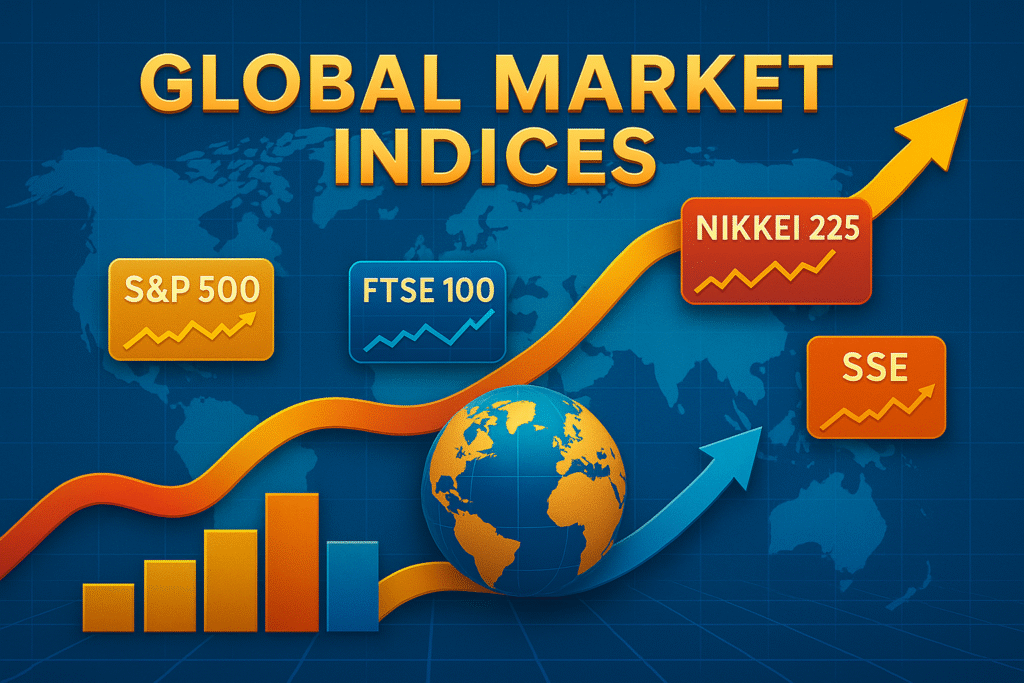Broad benchmarks track the performance of major asset classes—equities, bonds, commodities, real estate, and alternatives—across multiple countries, thereby giving investors a single, comparable view of how the world’s capital markets are moving. Accordingly, understanding their construction and uses is critical for both strategic allocation and tactical decisions.

1. Why They Exist
With more than US $300 trillion in listed assets worldwide, investors need standard yard-sticks so that they can summarise complex, cross-border markets. Consequently, global indices distil millions of trade-level prices into daily numbers that guide portfolio construction, performance reporting, and macro analysis.
2. Equity Benchmarks
| Index | Coverage | Weighting | Key Fact | Transition Note |
|---|---|---|---|---|
| MSCI ACWI | 47 developed + emerging markets | Free-float cap | ~2 800 stocks, 60 % U.S. | First and foremost, the broadest standard. |
| FTSE All-World | 49 countries | Free-float cap | Adds small-caps to large/mid | Meanwhile, deeper market breadth. |
| S&P Global 100 | Mega-caps only | Cap-weighted, capped | 100 blue-chip multinationals | By contrast, focuses on giants. |
| STOXX Global 1800 | 24 countries | Cap-weighted | Blend of Europe, Americas, Asia-Pac | Finally, offers regional balance. |
Therefore, these indices serve as default benchmarks for global-equity funds and ETFs.
3. Bond Benchmarks
| Index | Coverage | Duration | 2025 Yield | Transition Note |
|---|---|---|---|---|
| Bloomberg Global Aggregate | Treasuries, credit, securitised in 25 currencies | 6.8 yrs | 3.15 % | To begin with, the flagship composite. |
| FTSE World Government Bond Index (WGBI) | 23 sovereign curves | 8.0 yrs | 2.55 % | Meanwhile, pure sovereign exposure. |
| JP Morgan GBI-EM Global | 20+ local-currency EM bonds | 6.2 yrs | 7.1 % | In addition, higher-yield frontier risk. |
Global bond indices thus help allocators balance currency, duration, and credit exposure.
4. Real-Asset & Alternative Benchmarks
| Asset Class | Index | Highlight | Transition Note |
|---|---|---|---|
| Commodities | S&P GSCI (production-weighted), Bloomberg Commodity (capped) | Energy-heavy vs. diversified | First, choose depending on risk tilt. |
| Listed Property | S&P Global REIT | 270 + equity REITs, U.S. ~55 % | Meanwhile, captures income real estate. |
| Infrastructure | Dow Jones Brookfield Global Infrastructure | Pure-play revenue screen | Furthermore, focuses on cash-flow stability. |
| Hedge-Fund Proxy | HFRX Global Hedge Fund | Daily, investible fund basket | Finally, approximates alt beta. |
5. How Investors Use Global Indices
- Strategic Asset Allocation. A classic 60/40 portfolio often blends MSCI ACWI with Bloomberg Global Aggregate; thereafter, weights adjust to risk budgets.
- ETF Underpinning. Low-cost funds track index rules, consequently delivering instant diversification.
- Risk Management. Daily returns feed into VaR, stress tests, and factor models; thus, exposures stay transparent.
- Policy & Research. Central banks as well as academics monitor broad indices in order to glean systemic signals.
6. Strengths and Caveats
| Strengths | Caveats |
|---|---|
| Transparent, rules-based, widely published yard-sticks. | However, market-cap weights can over-allocate to over-valued regions. |
| Daily pricing enables timely comparison. | Meanwhile, free-float adjustment may under-represent restricted markets. |
| Long history aids back-testing and scenario analysis. | Additionally, currency translation introduces FX noise. |
7. Emerging Trends
- ESG & Climate Tilt. Low-carbon and net-zero versions of flagship indices are rapidly gaining AUM; therefore, sustainability is moving mainstream.
- Factor & Smart-Beta. Global multi-factor indices re-weight by value, momentum, or quality; consequently, they cater to style investors.
- Digital Delivery. On-chain index tokens promise 24/7 trading and instant settlement; moreover, they could cut operational friction.
- Blended Benchmarks. Providers now offer turnkey mixes like 60/40 or 50/30/20 (equity/bond/alt), thus simplifying multi-asset exposure.
Key Takeaways
Global multi-asset indices supply consistent, comparable snapshots of equities, bonds, commodities, real estate, and alternatives. Because design choices—coverage, weighting, rebalance—drive exposures, investors must stay alert to methodology changes. Ultimately, using these benchmarks wisely enhances allocation decisions, risk controls, and performance insight across the full spectrum of capital markets.
o3